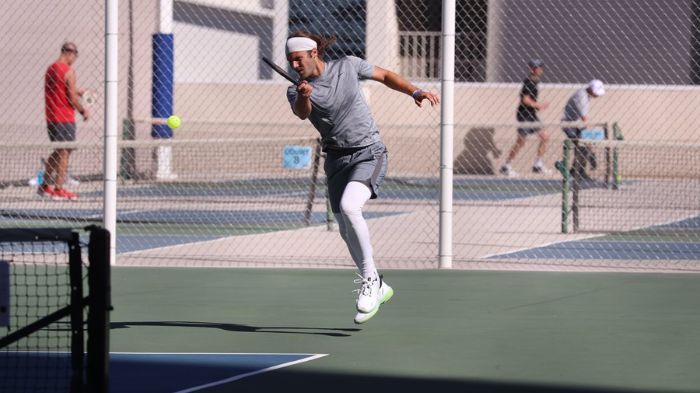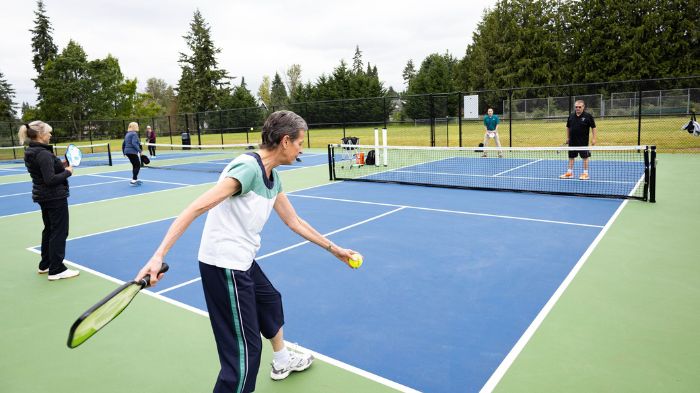Pickleball, a fast-paced and exciting sport that combines elements of tennis, badminton, and ping pong, has gained immense popularity in recent years. Within this sport, players are constantly seeking innovative techniques to gain an advantage over their opponents.
One such technique that has caused a significant stir within the pickleball community is the Chainsaw Serve. This unique and controversial serving technique involves the player using both hands to generate spin on the ball as it is tossed into the air. The resulting spin can make the ball difficult to return and adds an element of unpredictability to the game.
In this article, we will delve into the intricacies of the Chainsaw Serve, its origins, its impact on gameplay, and the ongoing debates surrounding its fairness and suitability in both professional and amateur pickleball play. Whether you are a pickleball enthusiast or simply curious about this fascinating sport, join us as we explore the controversial world of the Pickleball Chainsaw Serve.

What Is The Chainsaw Serve In Pickleball?
Have you ever heard of the chainsaw serve in pickleball? It’s quite a unique and controversial technique where a player uses their paddle to generate spin on the ball as they toss it into the air. The serve gained popularity after pro pickleball Zane Navratil started experimenting with different types of spin using the paddle face, paddle hand, and tossing hand.
- Navratil discovered that by rolling the ball along the face of the paddle, and sometimes even along the handle, as it’s tossed in the air, he could create an incredible amount of spin on the ball even before striking it. This resulted in a fast-spinning ball that traveled in unpredictable ways through the air and bounced off the court surface in unexpected directions.
- The challenging part for the receiving player is that even if they manage to get their paddle on the ball, the spin can cause it to rebound wildly off the paddle face, making it extremely difficult to control and intentionally return.
- This unique serve started gaining popularity among both recreational and professional players a few years ago, and by 2021, it had become quite common on pickleball courts at all levels.
- However, as the chainsaw serve became more prevalent, it sparked concerns about how it was affecting the integrity of the game. Some argued that trick serves like this were compromising fair play and diminishing the reliance on traditional skills. This outcry prompted discussions about whether rules or restrictions should be put in place to address the issue and ensure a level playing field for all players.
- So, the chainsaw serve has definitely stirred up some controversy within the pickleball community. It’s an innovative technique that adds excitement to the game, but it also raises questions about fairness and the core skills involved. The debate continues about whether the chainsaw serve should be allowed, restricted, or even banned in certain settings.
Cutting-Edge Controversy
The controversy surrounding the Chainsaw Serve in pickleball arose due to concerns about its fairness and sportsmanship. Many pickleball communities expressed complaints about the serve, leading to USA Pickleball, the governing body of the sport in the United States, implementing new rules in 2022 to declare the chainsaw serve illegal.
The updated official rules state that the serve must be made with only one hand releasing the ball. While some natural rotation of the ball is expected during the release, any manipulation or spin imparted on the ball using any part of the body immediately prior to the serve is prohibited (Rule 4.A.5).
As the chainsaw serve requires the use of both hands, it is explicitly banned under the new rule. This change was made to address what many considered an unfair and unsportsmanlike method of serving the ball.
However, the decision to outlaw the innovative serving technique has prompted discussions and debates within the pickleball community. Some argue that banning the chainsaw serve was the right move to maintain fairness, while others question whether it was the correct decision, considering the potential for excitement and strategy that the serve brought to the game.
Unmasking The Controversy of Chainsaw Serve
Why the Chainsaw Pickleball Serve Ruffled Feathers The introduction of the Chainsaw Pickleball Serve has sparked heated debates among players and enthusiasts alike. Here, we uncover the reasons behind the controversy and the arguments from both sides of the spectrum.

- Enhancing the Spectacle: Supporters of the Chainsaw Pickleball Serve Advocates of the Chainsaw Pickleball Serve argue that it brings an additional level of excitement and entertainment to the game. They believe that the serve’s spin and unpredictability create a more dynamic playing experience, challenging players to adapt their advanced pickleball techniques and strategies and improving their overall skills.
- Leveling the Playing Field: Opponents of the Chainsaw Pickleball Serve Opponents of the serve contend that it introduces an unfair advantage, particularly for experienced players who have mastered the technique. They argue that the serve disrupts the balance of the game and reduces the reliance on traditional skills such as ball placement, strategy, and volleying.
Game On or Game Over?
The Fate of the Chainsaw Pickleball Serve in Amateur Play While the Chainsaw Pickleball Serve has been banned in professional play, its status in amateur matches remains a topic of contention. Here, we explore the potential outcomes and scenarios surrounding the future of the Chainsaw Pickleball Serve in amateur play.
- Embracing Innovation: Allowing the Serve in Amateur Play Some pickleball communities have embraced the Chainsaw Pickleball Serve, considering it an exciting addition to the game.
In these settings, amateur players are permitted to utilize the serve, promoting a more inclusive and diverse pickleball experience. This allows players to experiment with new techniques and adds an element of unpredictability to matches.
- Upholding Tradition: Restricting the Serve in Amateur Play On the other hand, some amateur leagues and clubs have chosen to follow the lead of professional organizations and ban the Chainsaw Pickleball Serve.
This decision ensures consistency across different levels of play and upholds traditional standards and techniques. It emphasizes the importance of fair competition and skill development in the game. Power serve in pickleball is also considered as important as chainsaw serve.
Also Read About: Toss The Ball Up When Serving In Pickleball
FAQs
The pickleball chainsaw serve is a controversial serving technique where a player uses both hands to generate spin on the ball as they toss it into the air. The motion resembles a chainsaw, with the player rapidly twisting the paddle along the ball’s surface, creating a buzzing sound and adding significant spin before striking the ball.
The pickleball chainsaw serve is controversial due to concerns about its fairness and impact on the game. Some argue that it provides an unfair advantage, as the spin generated can make the ball difficult to return and unpredictable in its trajectory. Opponents claim that it disrupts the balance of the game and reduces the reliance on traditional skills, such as ball placement and strategy.
No, the pickleball chainsaw serve is not allowed in professional play. Many governing bodies and organizations, including USA Pickleball, have implemented rules prohibiting the chainsaw serve. These rules state that the serve must be made with only one hand releasing the ball and that no manipulation or spin should be imparted on the ball with any part of the body immediately prior to the serve.
The use of the pickleball chainsaw serve in recreational or amateur play depends on the specific rules and regulations of the league, club, or organization you are playing with. While some communities may allow the chainsaw serve, others may choose to follow the guidelines set by professional organizations and ban it to maintain consistency across different levels of play.
Final Words
The Chainsaw Pickleball Serve has undeniably caused a stir within the pickleball community. While its ban from professional play suggests concerns regarding fairness and injury, its future in amateur matches remains uncertain.
Ultimately, the fate of the Chainsaw Pickleball Serve will depend on the perspectives and decisions of local communities, clubs, and organizations. As the sport continues to evolve, striking a balance between innovation and tradition will be crucial in shaping the future of pickleball.



